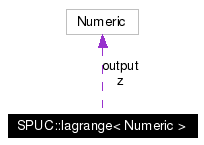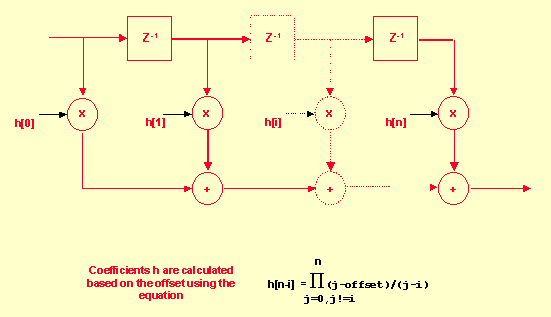
#include <lagrange.h>
Collaboration diagram for SPUC::lagrange< Numeric >:

Public Member Functions | |
| void | reset () |
| Numeric | out () |
| Get current output. | |
| Numeric | check (long i) |
| Clock in new sample & compute current output. | |
| lagrange (void) | |
| lagrange (long n) | |
| Constructor. | |
| ~lagrange (void) | |
| Destructor. | |
| void | set_size (long n) |
| Set order of polynomial. | |
| void | input (Numeric in) |
| Input new sample (do nothing else). | |
| Numeric | update (Numeric in, double offset) |
| Numeric | fir (void) |
| Calculate output for current coefficients. | |
| Numeric | rephase (double offset) |
| Rephase => recalculate coefficients and output for new offset (for upsampling). | |
| void | calculate_coeff (double offset) |
| Calculate coefficients given an offset. | |
| void | print () |
| Print out coefficients. | |
Public Attributes | |
| long | num_taps |
| double * | coeff |
Protected Attributes | |
| Numeric * | z |
| Numeric | output |
: Template Lagrange interpolation via FIR Fitler This works best for double or complex<double> Coefficients are always real (i.e. no imaginary parts).

|
||||||||||
|
|
|
||||||||||
|
Constructor.
|
|
||||||||||
|
Destructor.
|
|
||||||||||
|
Calculate coefficients given an offset.
|
|
||||||||||
|
Clock in new sample & compute current output.
|
|
||||||||||
|
Calculate output for current coefficients.
|
|
||||||||||
|
Input new sample (do nothing else).
|
|
|||||||||
|
Get current output.
|
|
||||||||||
|
Print out coefficients.
|
|
||||||||||
|
Rephase => recalculate coefficients and output for new offset (for upsampling).
|
|
||||||||||
|
|
|
||||||||||
|
Set order of polynomial.
|
|
||||||||||||||||
|
Update => Clock in new input sample, recalculate coefficients and determine output |
|
|||||
|
|
|
|||||
|
|
|
|||||
|
|
|
|||||
|
|
 1.4.4
1.4.4